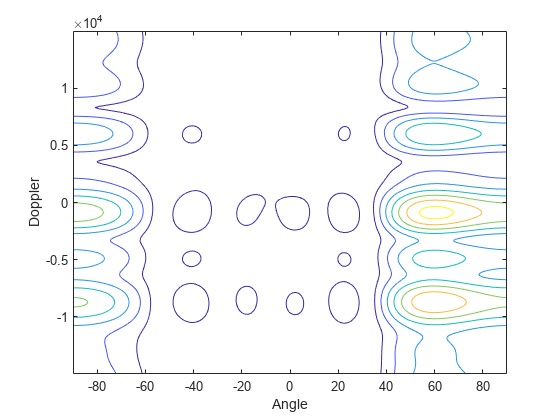step
System object: phased.AngleDopplerResponse
Namespace: phased
Calculate angle-Doppler response
Syntax
[RESP,ANG_GRID,DOP_GRID]
= step(H,X)
[RESP,ANG_GRID,DOP_GRID]
= step(H,X,ELANG)
RESP,ANG_GRID,DOP_GRID = step(H,X,PRF)
Description
Note
Starting in R2016b, instead of using the step method to perform the operation defined by the System object™, you can call the object with arguments, as if it were a function. For example, y = step(obj,x) and y = obj(x) perform equivalent operations.
[ calculates
the angle-Doppler response of the data RESP,ANG_GRID,DOP_GRID]
= step(H,X)X. RESP is
the complex angle-Doppler response. ANG_GRID and DOP_GRID provide
the angle samples and Doppler samples, respectively, at which the
angle-Doppler response is evaluated. This syntax is available when
the ElevationAngleSource property is 'Property'.
The size of the first dimension of the input matrix can vary to simulate a changing signal length. A size change can occur, for example, in the case of a pulse waveform with variable pulse repetition frequency.
[ calculates
the angle-Doppler response using the specified elevation angle RESP,ANG_GRID,DOP_GRID]
= step(H,X,ELANG)ELANG.
This syntax is available when the ElevationAngleSource property
is 'Input port'.
RESP,ANG_GRID,DOP_GRID = step(H,X,PRF)PRF as the pulse repetition frequency. This syntax is
available when the PRFSource property is 'Input
port'.
Note
The object performs an initialization the first time the object is executed. This
initialization locks nontunable properties
and input specifications, such as dimensions, complexity, and data type of the input data.
If you change a nontunable property or an input specification, the System object issues an error. To change nontunable properties or inputs, you must first
call the release method to unlock the object.
Input Arguments
| Angle-Doppler response object. |
| Input data as a matrix or column vector. If If |
| Elevation angle in degrees. You can specify this argument as single or double precision. Default: Value of |
| Pulse repetition frequency specified as a positive scalar. To enable this
argument, set the |
Output Arguments
| Complex angle-Doppler response of |
| Angle samples at which the angle-Doppler response is evaluated. |
| Doppler samples at which the angle-Doppler response is evaluated. |
Examples
Algorithms
phased.AngleDopplerResponse generates the response
using a conventional beamformer and an FFT-based Doppler filter. For
further details, see [1].
References
[1] Guerci, J. R. Space-Time Adaptive Processing for Radar. Boston: Artech House, 2003.
